I recently returned from a photo workshop in Monument Valley and Canyon de Chelley and I wanted to share with you a bit of the experience. It has been a few years since I was last in Monument Valley and getting back there reminded me of why I love this area so much. Wide opens spaces, towering sandstone monoliths, starry skies like you’ve never seen before and then the remnants of long ago civilizations to marvel at. It was an amazing trip and I wanted to share a bit of the experience with you.
I flew from Portland Oregon to Albuquerque New Mexico where I met my partner Jack Graham who had driven out from Tennessee. We quickly left the city and headed West towards 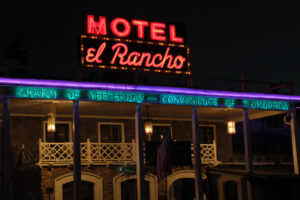 Gallup New Mexico. Along the way, we stopped at a few locations that had old signs and abandoned buildings, trying to capture a bit of the vibe of the historic Route 66. After a couple of hours, we arrived at Gallup NM and our hotel for the next couple of days. We decided to stay at El Rancho, which is a famous hotel from the Route 66 days and has had many famous guests stay there. The hotel hasn’t changed much since the ’50’s and is decorated with framed photographs of movie stars and directors and each room is named after a movie star that stayed with them. I have to say, it was a bit kitchy, but that just further added to the specialness of this trip. The food was good and the location was central to what we wanted to do there, so it was perfect!
Gallup New Mexico. Along the way, we stopped at a few locations that had old signs and abandoned buildings, trying to capture a bit of the vibe of the historic Route 66. After a couple of hours, we arrived at Gallup NM and our hotel for the next couple of days. We decided to stay at El Rancho, which is a famous hotel from the Route 66 days and has had many famous guests stay there. The hotel hasn’t changed much since the ’50’s and is decorated with framed photographs of movie stars and directors and each room is named after a movie star that stayed with them. I have to say, it was a bit kitchy, but that just further added to the specialness of this trip. The food was good and the location was central to what we wanted to do there, so it was perfect!
The next day we enjoyed a great breakfast at the Route 66 Diner, which was the quintessential 1950’s dinner with red & white checked tables, soda fountains and all the memorabilia from the area. After a great meal, we headed west to check out a few locations in the area that we hadn’t been too before, or it’s been too many years to remember. Once we hit our stops, we still had most the day, so we decided to head further West and visit the Petrified Forest National Park. This is not a N.P. that I ever envisioned visiting or photographing because it just didn’t seem like there was enough there to warrant a special trip just to this park. But since we were in the area, I was excited to visit it and check another NP off my list.
At first glance past the entrance station, it wasn’t too awe inspiring. Granted it was 92 degrees under clear skies, so we were a bit hot, yet still, the landscape looked a lot like the Painted Hills area of Eastern Oregon. Feeling a bit un-inspsired, we pressed on the 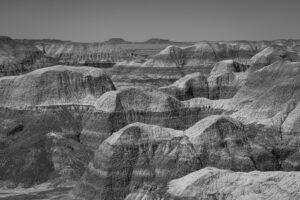 loop road towards more of the petrified areas of the park. As we headed South, the topography changed and soon there were gulleys, canyons and hills. There are many parking areas and we got out to check out the views. The photography wasn’t great because the light was harsh, yet I still took a few “tourist snaps” to document my visit. One of the features that brought me some creative energy was the layers of sediment and how the hills all stacked up in to repeating patterns (left).
loop road towards more of the petrified areas of the park. As we headed South, the topography changed and soon there were gulleys, canyons and hills. There are many parking areas and we got out to check out the views. The photography wasn’t great because the light was harsh, yet I still took a few “tourist snaps” to document my visit. One of the features that brought me some creative energy was the layers of sediment and how the hills all stacked up in to repeating patterns (left).
Eventually we made it to an area that featured more of the petrified wood that we had some to see. 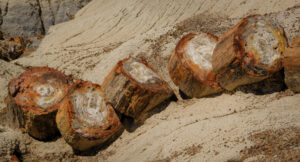 There were two or three main areas featuring hundreds of specimens and it really was a marvel to contemplate the eons of time involved to turn wood in to stone. It’s a fascinating process how the trees were covered in a sediment that protected them from the elements, then the chemicals in the soil gradually turned the wood to stone, preserving all of the details of the wood, including bark rings, etc. After several hours wandering the paths and marveling and the landscape and petrified wood, we decided to head back to the hotel and grab a quick dinner before packing for an early departure the next day.
There were two or three main areas featuring hundreds of specimens and it really was a marvel to contemplate the eons of time involved to turn wood in to stone. It’s a fascinating process how the trees were covered in a sediment that protected them from the elements, then the chemicals in the soil gradually turned the wood to stone, preserving all of the details of the wood, including bark rings, etc. After several hours wandering the paths and marveling and the landscape and petrified wood, we decided to head back to the hotel and grab a quick dinner before packing for an early departure the next day.
The next day, our ultimate goal was to make it to Monument Valley and make several stops along the way to scout out locations for the workshop. We decided to visit Shiprock for sunrise since that would make for a great sunrise location. Unfortunately it was 2 hours away from our hotel so before 4am we were loaded and on the road. Shiprock is a modanock rising over 1500′ from the valley floor. Amidst the flat landscape, it rises up to imposing heights. We found a great location off the road that provided a good angle on the monolith and photographed it as the sun slowly rose in the east. We wanted to fly our drones over the spine leading up to the rock, but this land, like most Navajo land, is a no drone zone, so we did not fly. Still, we had wonderful pastel colors pre-sunrise and then once the sun rose and shone on the rock, the photography was over and we hit the road to head West towards Monument Valley.

Sunrise at Shiprock in New Mexico
We left New Mexico and crossed in to Utah on our way to Monument Valley. It’s a couple of hours from Shiprock to our hotel in the Valley and we had a few stops along the way (again) to scout locations for the workshop. We took the long road out to Goosenecks State Park which is in the Bears Ears National Monument. This location is amazing to see from the one viewpoint as the river has cut a deep, deep channel in the rock that folds back upon itself repeatedly, looking like the curve in a gooses neck. I shot a few panorama sequences with the goal to have them in monochrome to highlight the texture, shape and light/shadow of the mid-day sunlight. From there, we continued headed West through the Mexican Hat area. The light was not good at all to photograph the hat, so we continued on towards our next stop….Forest Gump Point. Yes it’s cliche, but it is quite a sight to see the road stretching off in to the distance. And, stopping here is a source of amusement as there are a lot of folks who come to this point to take photographs of the road, and in the road, for themselves. So watching them dodge traffic, lay down in the road, pose for their social media accounts, etc, is a source of entertainment. The main pullout at the top of the hill is where most people stop, however there are a couple of more pullouts further down the road and I actually prefer the perspective at the lower viewpoints over the higher ones. And, there are fewer people jockeying for position in the road. It really is an iconic shot of the Desert Southwest!
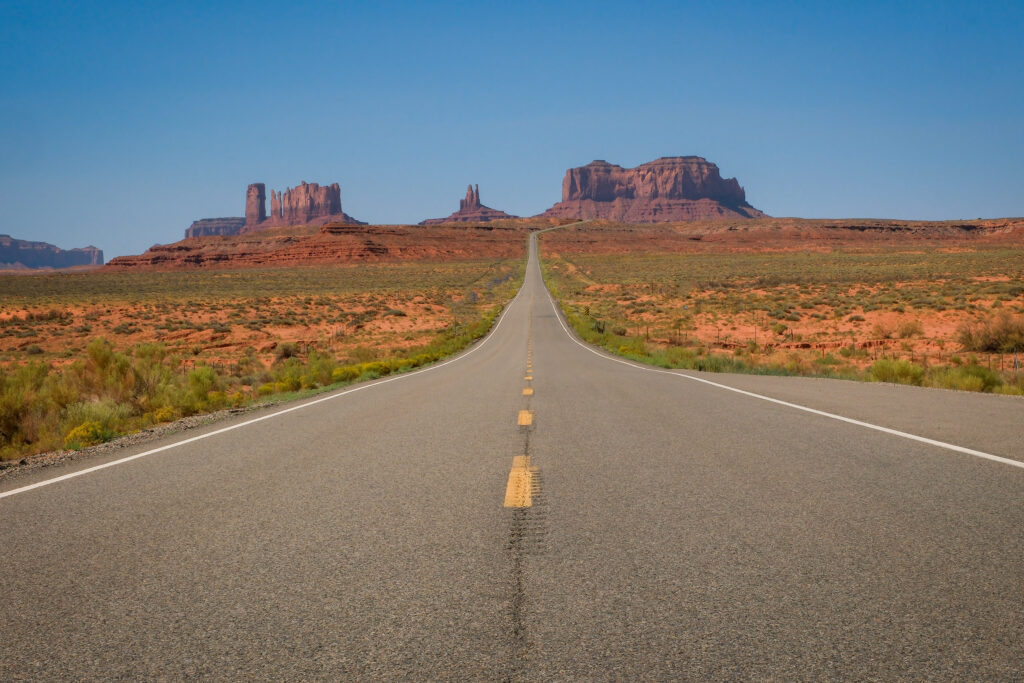
Leaving the Forest Gump Point, it was a quick drive down to the Valley proper and to our hotel for the next few days. There are two main places to stay in Monument Valley, The View is a newer hotel built near the Mittens and offers an impressive view at a commensurate price. Gouldings is the other hotel there and is the place we’ve stayed for years. It is set back from the valley just a bit, nestled on the side of a bluff with an expansive view of the entire valley.  The other neat thing about Gouldings is that they own several houses near the main hotel, located up a side canyon, and once again we rented out the houses for our workshop. Our particular house sat on a pinnacle of rock overlooking the valley and when you open the back door and step on the patio, you are greeted by an incredible view. We unpacked our gear and made a run to the grocery store to stock up on food and beverages. That night, after cooking dinner in our house, I grabbed my camera and went on the back patio to shoot a few star shots with the surrounding cliffs lit up by faint light from the houses. We enjoyed the houses and weren’t far from the hotel dining room if we didn’t want to cook, so all in all, a great recommendation when staying at Gouldings!
The other neat thing about Gouldings is that they own several houses near the main hotel, located up a side canyon, and once again we rented out the houses for our workshop. Our particular house sat on a pinnacle of rock overlooking the valley and when you open the back door and step on the patio, you are greeted by an incredible view. We unpacked our gear and made a run to the grocery store to stock up on food and beverages. That night, after cooking dinner in our house, I grabbed my camera and went on the back patio to shoot a few star shots with the surrounding cliffs lit up by faint light from the houses. We enjoyed the houses and weren’t far from the hotel dining room if we didn’t want to cook, so all in all, a great recommendation when staying at Gouldings!
Once the group arrived, we did a quick meet and greet with everyone and discussed the itinerary for the coming days. The plan was to spend 3 1/2 days in Monument Valley and then drive South to Chinle and spend a day in Canyon de Chelley. After our meeting, we loaded up and headed to The View to catch sunset over the valley. Because we visited in September, the monsoon season was in full swing so there were clouds and a chance of rain on the horizon. And, the timing of this trip coincided with the “Mitten Shadow Event” where the West Mitten casts a shadow on the East Mitten that is a virtual copy, just flipped. It’s quite a sight to see. However, on this night, we had pretty solid cloud cover and didn’t get any sunset color or shadows. Still, we got some great shots with drama in the sky! In the desert, I would much prefer clouds over blank skies as it allows me much more creativity opportunity than just 5 minutes of sunrise and then done.

Because Monument Valley is located in the Navajo Nation, you will need a Navajo guide to get you to some of the best locations. There is a loop drive that you can do through the valley which is pretty and nice, but it doesn’t go to locations that we as photographers want to go. So we called upon our longtime guides and friends to take our group deep in to the valley the next day. We met the guides well before sunrise and loaded in to their Suburbans for the drive in to the Valley and our sunrise location. After a 25 minute drive over rocky and sandy roads, we headed more off-road on guided trails. Thankfully the guides know where to go because in the dark, every trail looks the same! Eventually we came to a wide spot in road and parked the trucks. We unloaded and shouldered our packs for a short walk to the Totem Pole area.
This is one of the iconic shots in Monument Valley, the Totem Pole and the 3 Sisters alongside. There are a bunch of sand dunes on the way to the Totem Pole and it is here that we set up for sunrise. Having the wind shaped ridges of sand dunes in the foreground makes this shot so special and everyone worked the area capturing many different angles of this scene with the flowing sand dunes in front. The best light, in my opinion, occurs pre-sunrise during the blue hour. Since we are not shooting the sunrise event itself, having muted and even light on the sandstone rocks is what I want. Once the direct sunlight hits the rocks, the exposure becomes very difficult and the contrast becomes un-appealing in my opinion. Here is my take on that beautiful scene, although I still have some post-processing work to finish on this, I figured I’d share it with you anyways.
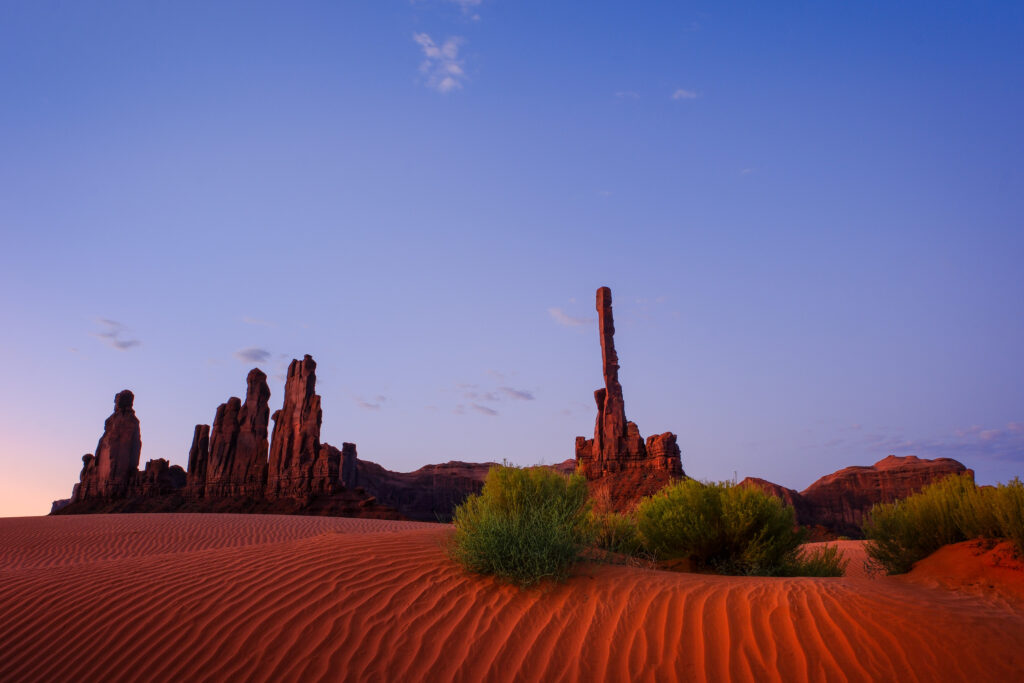
Once the sun rose, we hiked back to our vehicles and made the short drive to our next location. As we pulled up alongside a rock wall,  all eyes turned upwards to view the Suns Eye, a large arch in the sandstone far above our heads. This is a fantastic arch to see and can be challenging to photograph. In a perfect world I would have loved some clouds in the sky to show through the arch, but instead we had clear blue skies. So, I positioned myself (and the clients) close to the wall to use the varnish on the rocks as another piece of visual interest in the photograph.
all eyes turned upwards to view the Suns Eye, a large arch in the sandstone far above our heads. This is a fantastic arch to see and can be challenging to photograph. In a perfect world I would have loved some clouds in the sky to show through the arch, but instead we had clear blue skies. So, I positioned myself (and the clients) close to the wall to use the varnish on the rocks as another piece of visual interest in the photograph.
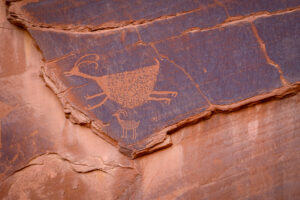 Very close to this point there were some petroglyphs carved in to the rock. We were able to get up close with them and take a lot of images at various angles. Besides photography, I found myself just looking at these ancient images carved with rudimentary tools by people that lived many years ago and felt a sense of wonder and awe at what I was seeing. I don’t get exposed to things like this as much as I’d like, so when it happens, I try to take time to appreciate the moment and make sure to store it in my memory.
Very close to this point there were some petroglyphs carved in to the rock. We were able to get up close with them and take a lot of images at various angles. Besides photography, I found myself just looking at these ancient images carved with rudimentary tools by people that lived many years ago and felt a sense of wonder and awe at what I was seeing. I don’t get exposed to things like this as much as I’d like, so when it happens, I try to take time to appreciate the moment and make sure to store it in my memory.
The Suns Eye is located in a natural amphitheater with sheer sandstone walls rising high overhead. At the base of the walls there was an abundance of small plants, rocks, trees and other desert debris that made for some wonderful intimate desert photographs. This one area, dubbed “Gods Garden” by one of the folks really was one of my favorite small areas to photograph. So much to do that I hated leaving when it was time!

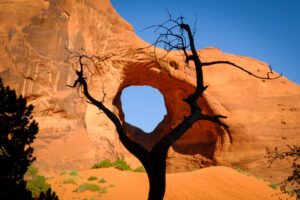 Unfortunately our time here in this Eden had to end so we loaded up and headed off to the next feature, the Ear of the Wind. Another sandstone arch, this one was located much closer to the ground so we could incorporate some foreground elements if we choose. Being a bright and sunny day, the exposure was impossible in one frame, so we either had to bracket exposures, or, use the massive contrast to our advantage. Conveniently located, a tree provided a nice silhouetted frame to the arch. Here again we were drawn to the small scenes all around us after photographing the wider, more obvious subject. Rocks, plants, old sticks….each took on a very unique quality in this landscape.
Unfortunately our time here in this Eden had to end so we loaded up and headed off to the next feature, the Ear of the Wind. Another sandstone arch, this one was located much closer to the ground so we could incorporate some foreground elements if we choose. Being a bright and sunny day, the exposure was impossible in one frame, so we either had to bracket exposures, or, use the massive contrast to our advantage. Conveniently located, a tree provided a nice silhouetted frame to the arch. Here again we were drawn to the small scenes all around us after photographing the wider, more obvious subject. Rocks, plants, old sticks….each took on a very unique quality in this landscape.
We loaded up for our final stop of the morning, at a property in Monument Valley. We have visited this family for many years, 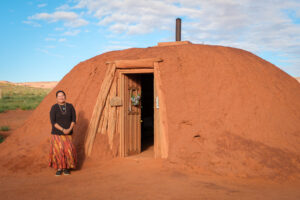 bring our groups here and either the mom, or one of her daughters, dresses up a bit and sits in their hogan for us to photograph her. On this visit, it was the daughter and after posing inside for us, she came out and posed next to the hogan. She shared about what life was like growing up as a child in the valley as well as some info about the Navajos in general. By the way, a hogan is a Navajo dwelling used for ceremonies as well as living. Made out of fallen branches, woven in to a dome, it is then covered with dirt and mud to keep out the elements.
bring our groups here and either the mom, or one of her daughters, dresses up a bit and sits in their hogan for us to photograph her. On this visit, it was the daughter and after posing inside for us, she came out and posed next to the hogan. She shared about what life was like growing up as a child in the valley as well as some info about the Navajos in general. By the way, a hogan is a Navajo dwelling used for ceremonies as well as living. Made out of fallen branches, woven in to a dome, it is then covered with dirt and mud to keep out the elements.
Saying our goodbyes, we loaded up for the drive out of the valley and back to our vehicles. We headed back to the hotel to eat breakfast and prepare for the trip up to the top of Hunts Mesa. Cleaning the camera sensor was a priority because dust gets everywhere as well as making sure I had a full compliment of charged batteries since there is no electricity on top the mesa. I brought along a small backpack just for this trip and in it I stuffed a raincoat, change of socks and a couple of energy bars to stave off any hunger that might creep up. We all met up mid-afternoon and took a short drive to the guides house to leave our vehicles and load in to their trucks.
The trip to the top of Hunts Mesa is one of the highlights of the workshop. We drive up dirt roads, then steep rocky inclines to a camp that is set up on top of the mesa that overlooks Monument Valley. The drive is almost indescribable, especially to those who’ve never done any off-roading. We took two older suburbans to carry us and our gear and one pickup to carry our camp supplies. These trucks are un-modified and one of them was running on street tires, but the terrain we climbed was jaw dropping for such a big, heavy and stock vehicle. Instead of trying to describe it, I shot a video of the drive up that you can watch below.
On the way to the top we stopped several times to stretch our legs or take in the view or at particularly beautiful locations, got out our cameras and tripods for a photo session. Eventually we made it up to the campsite before sunset and unloaded our vehicles. Our individual tents had already been set up by the guides and each featured a cot, sleeping bag and pillow inside. We quickly claimed our tents and then grabbed our gear for sunset on the Mesa. It was a memorable time with clouds overhead interspersed with sunlight. The featured image for this post was from Hunts Mesa as well as the one below. Both color and monochrome worked well here!
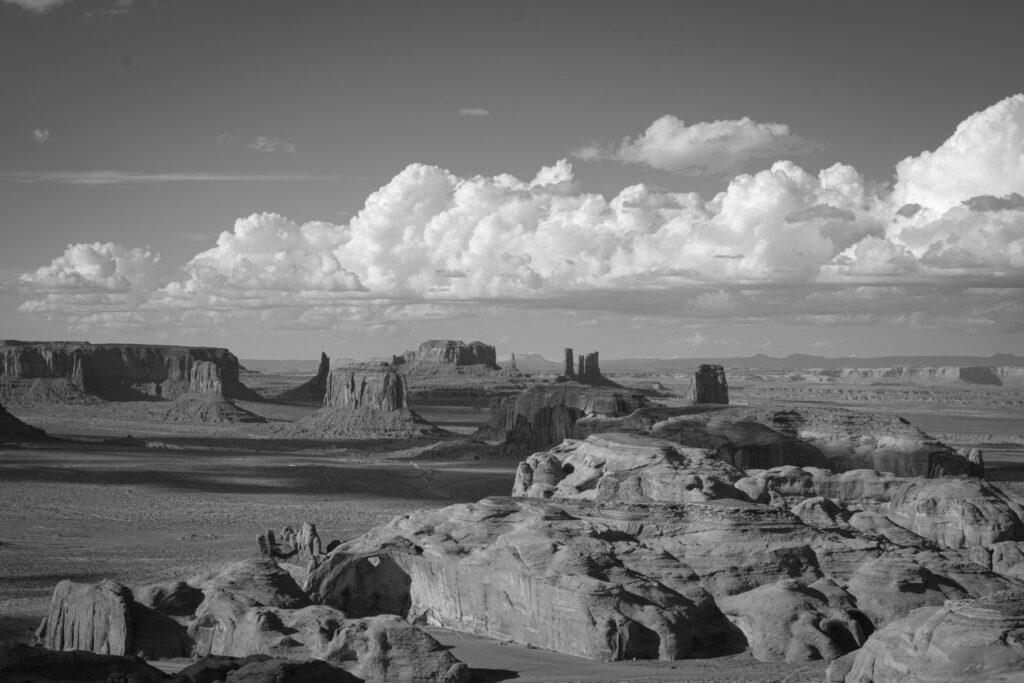
As we were photographing, our guides were busy cooking chicken, steak and 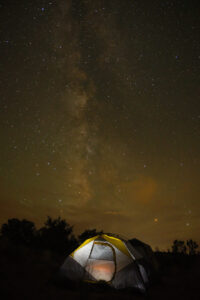 potatoes in the campfire. We stowed our gear and then sat down at portable picnic tables to feed our hungry inner photographers! By the time dinner ended, most everyone was worn out from the early morning and exciting day, so most retired to their tents. A few of us stayed up because of the prospect of photographing the stars and Milky Way overhead. In the end, there was 4 of us and one got the idea to put a small light in a tent that lined up well with the Milky Way. We experimented with different Kelvin temperatures to create cool or warm images of Milky Way as it travelled across the sky (or we rotated underneath it). We went to bed eventually with increasing clouds and thunderstorms overnight. Most of us got some sleep, but a few were a bit groggy in the morning.
potatoes in the campfire. We stowed our gear and then sat down at portable picnic tables to feed our hungry inner photographers! By the time dinner ended, most everyone was worn out from the early morning and exciting day, so most retired to their tents. A few of us stayed up because of the prospect of photographing the stars and Milky Way overhead. In the end, there was 4 of us and one got the idea to put a small light in a tent that lined up well with the Milky Way. We experimented with different Kelvin temperatures to create cool or warm images of Milky Way as it travelled across the sky (or we rotated underneath it). We went to bed eventually with increasing clouds and thunderstorms overnight. Most of us got some sleep, but a few were a bit groggy in the morning.
Sunrise on the Mesa was a cloudy affair, though we still had an amazing view of Monument Valley. We shot moody scenes with the dramatic clouds or put on long lenses to isolate details. Lacking sunrise color, everyone still created some amazing images of the valley. Once done, we had a wonderful cooked breakfast and then broke camp, loaded up and drove down the Mesa. Again, a very exciting ride! We eventually made it back to our vehicles and then hotel for a much needed shower and short rest. The plan was to meet our guides later in the afternoon for a trip in to Mystery Valley. We assembled at the meeting point just as the skies opened up and dumped inches of rain on us. In discussion with our guides, we decided it was too wet to safely navigate the backcountry, so we made plans to retreat for the afternoon and attempt it again the following day. So, back to the hotel for a longer rest, image processing and sensor cleaning while the heavens opened up.
We agreed to meet up again for an attempt at sunset at the Mittens. Still not having seen the “shadow event”, Jack and I were eager for folks to see this. However, there were still a LOT of clouds in the sky, so much so that we were doubtful that we’d see any sunlight. But as the old saying goes, “you won’t know if you don’t go” so we headed over to The View to see what could happen. Wouldn’t you know it, just as the sun dipped very low in the horizon, there was a gap in the clouds which allowed sunlight to bathe the valley and create shadows. The Mitten Shadow was happening! It was such a great thing to see. And the bonus this year was that since they’d gotten so much rain in the Valley, the foliage was a beautiful green, contrasting with the red rocks, adding more visual interest to an already interesting scene!
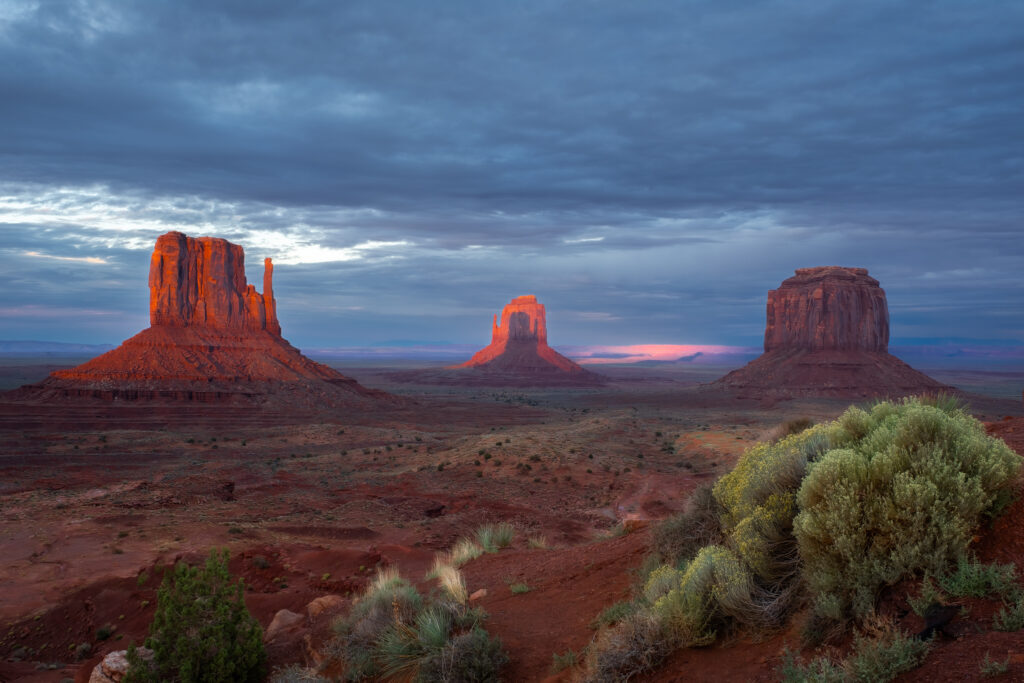 After sunset it was off for a quick dinner and bed. We were all tired from the past couple of days and needed some good sleep to recharge our creative energy.
After sunset it was off for a quick dinner and bed. We were all tired from the past couple of days and needed some good sleep to recharge our creative energy.
By the next morning the rain had stopped and it was dry enough for us to make it in to Mystery Valley. We headed back to The View to photograph sunrise behind the Mittens and then met our guides for the trip in to the Valley. After a short on-road bit, we headed off-road towards our various locations. For the sake of length, I won’t go in to depth for this article, however, it was an amazing location to visit. Pancake rocks, arches, sweeping views….Mystery Valley sure provided a full mornings worth of photograph opportunities. As a last stop on our way out of the valley, we stopped at the famous John Ford Point overlooking Monument Valley. This location has been filmed hundreds of times in various Hollywood western movies and though iconic and a bit cliche, it was worth the stop.
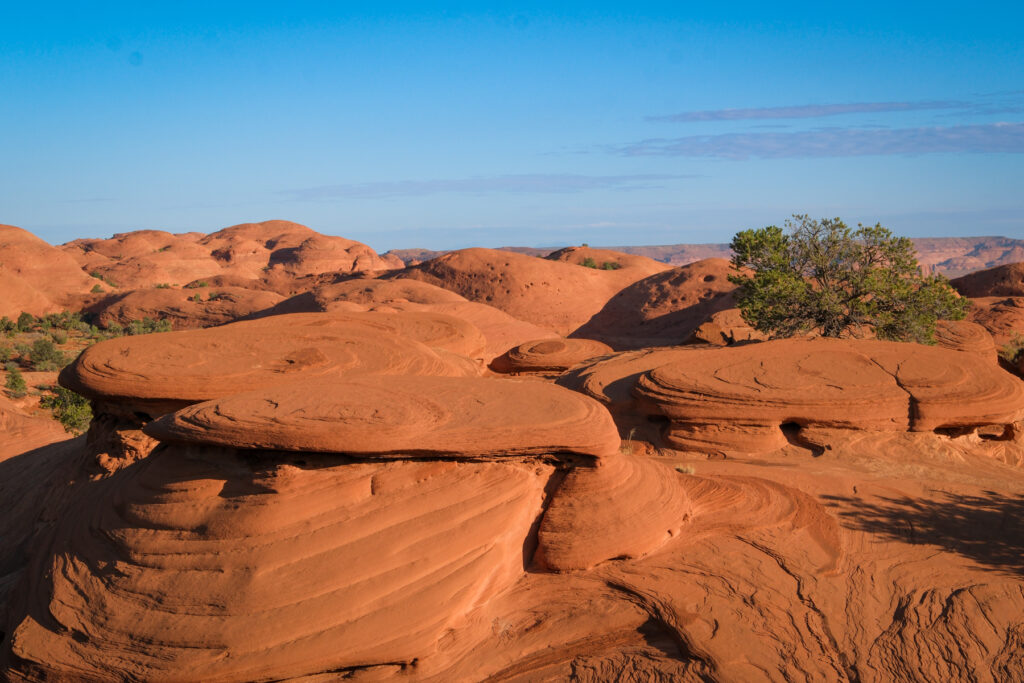
We spent the morning in the valley and then returned to our trucks and back to the houses to check out of Gouldings and move our workshop to Chinle. The drive to Chinle from Monument Valley takes about 1 1/2 hours through the barren desert. For those not used to this landscape, it sure is an eye opener.
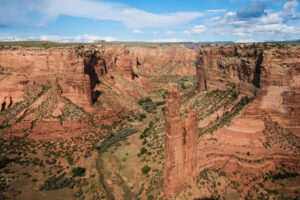 We checked in to the Holiday Inn in Chinle, one of the best places to stay in town as it’s not located in the town itself and is fairly secure with a nice restaurant. Once settled, we loaded up to drive up the rim of Canyon de Chelley to the Spider Rock Overlook. Spider Rock is a spire that rises 830′ above the valley floor and seems to defy gravity and the ravages of time. We walked the paved path out to the overlook and were able to photograph it before the shadows crossed the spire. Plus, many spent time in the surrounding area photographing the canyon or the small desert scenes all around us. We returned to the hotel and had a nice dinner in the hotel restaurant before retiring to our rooms to charge batteries and rest up for the day ahead.
We checked in to the Holiday Inn in Chinle, one of the best places to stay in town as it’s not located in the town itself and is fairly secure with a nice restaurant. Once settled, we loaded up to drive up the rim of Canyon de Chelley to the Spider Rock Overlook. Spider Rock is a spire that rises 830′ above the valley floor and seems to defy gravity and the ravages of time. We walked the paved path out to the overlook and were able to photograph it before the shadows crossed the spire. Plus, many spent time in the surrounding area photographing the canyon or the small desert scenes all around us. We returned to the hotel and had a nice dinner in the hotel restaurant before retiring to our rooms to charge batteries and rest up for the day ahead.
The last day of our workshop we had planned an excursion in to Canyon de Chelley with a group of local Navajo that we have worked with for years. The canyon in in the Navajo Nation and it is required to have a guide to go in to the canyon, so we met our three guides, and their vehicles at the hotel before a short drive to the tribal office to get our trip permits. Once properly permitted (and had paid our dues) we took a short drive up the road before we turned off the pavement and on to the sandy wash of the canyon floor. For nearly 5,000 years, people have lived in these canyons – longer than anyone has lived uninterrupted anywhere on the Colorado Plateau and they are still living there today. Our lead guide has property in the canyon and that was our destination for lunch and the midway point of our exploration.
The first stop we visited a location with a beautiful collection of 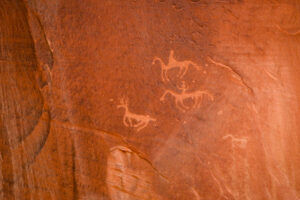 petroglyphs and small scenes to photograph. We spent about 45 minutes in this location before having to move along to the next, and perhaps most famous location in the canyon.
petroglyphs and small scenes to photograph. We spent about 45 minutes in this location before having to move along to the next, and perhaps most famous location in the canyon.
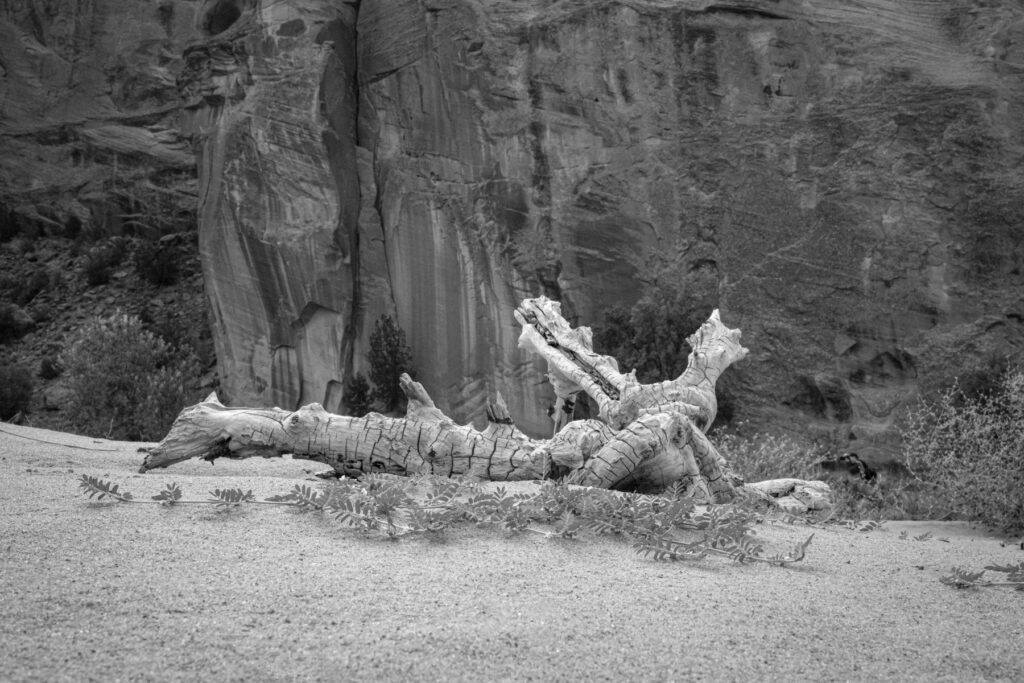
Our next stop was an area that features cave dwellings and other structures built on the valley floor. The White House site, with its origins around 1070, stands as a silent witness to the lives of those who once called it home. The lower ruin, which once had around 60 rooms, is complemented by the upper alcove site with 20 rooms, including four kivas. Together, these structures provided shelter to at least 50 individuals. Today, only half of the lower ruin remains visible, with parts having been washed away in the early 20th century. Excavations over the years have unveiled burial sites, tools, projectile points, and a rich collection of pottery. This location was made famous photographically by Ansel Adams who used the varnish on the walls above the ruins to create a stunning photograph.
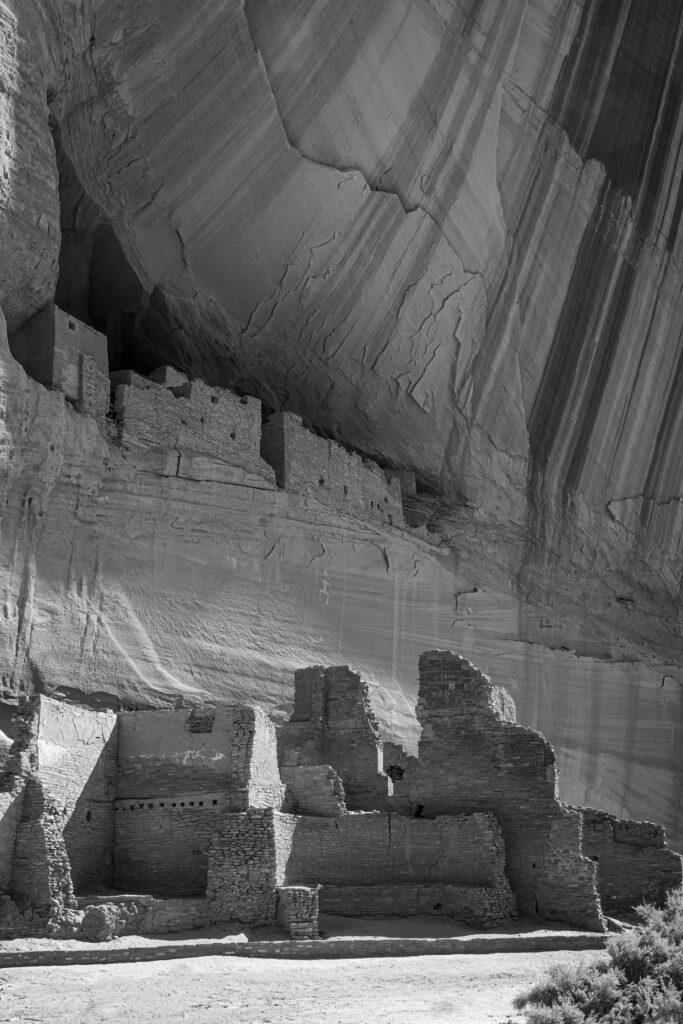
It was awe inspiring to see these ruins and reflect on the people who used to live here. No matter how many times I’ve been here, I have the same amazing reactions in this beautiful land. After spending a couple of hours in this location, photographing the ruins and the surrounding area, we loaded up and headed a ways up the canyon to the property of our guide, Oscar.
Oscar grew up as a child in the canyon and told us stories of hearing the school bus honk it’s horn from the road on top the canyon rim and he would run up the valley and climb the steep walls to catch the bus to school. Then after school he would climb back down the canyon to home. Hearing these stories of how the people grew up close to the land, and the challenges they faced, gave me a new appreciation for how good I have it.
One of the cool parts of his property is that there are both petroglyphs 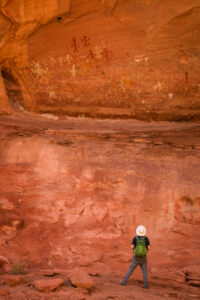 and hieroglyphs on the walls near his hogan. We spent time marveling at these ancient works of art, and forms of communication, as well as the surrounding area.
and hieroglyphs on the walls near his hogan. We spent time marveling at these ancient works of art, and forms of communication, as well as the surrounding area.
We had picked up a box lunch from the hotel and we all enjoyed a nice lunch surrounded by amazing scenery. As the spirit moved us, we would wander off to photograph something and believe me, there was a lot to shoot. From towering red walls to prickly pear cactus on the valley floor, everyone found something to photograph.
After an hour or so, we decided to load up and start heading back towards the entrance to the canyon. This time of year is monsoon season and late afternoon thunderstorms are always a possibility. On this day, we could see the clouds building in the sky, pregnant with rain and we did not want to be stuck in the valley when a deluge occurred. At the least the trail would be impassable and at the worst a flash flood could occur as we saw plenty of evidence of past floods as we drove. With some urgency, we made our way down the canyon. We did stop at one location that was interesting for folks to see and that was where a lone tree was seemingly growing out of the rock. The horizontal layers of rock provided a nice graphical element to contrast against the pinion pine tree growing.
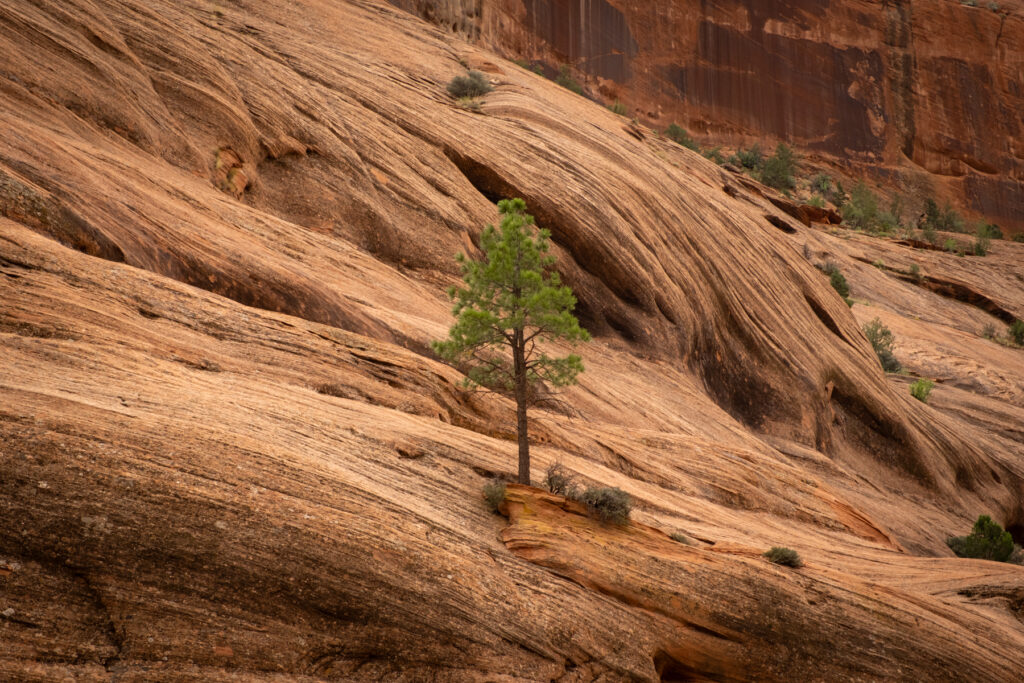
We made it back to our hotel before the rains arrived. Everyone was tired for sure, but oh so satisfied with the amazing experience we had in the canyon. We officially wrapped up the workshop and said goodbyes to those who wanted to hit the road towards home. Since Jack and I weren’t leaving until the following day, we invited a few folks to head out and explore the north rim of the canyon, as there are various lookouts that offer beautiful views down in to the canyon as well as some ruins. We visited several locations and each one provided much to see and photograph. From wide open vistas to small intimate scenes, we squeezed the last of our creativity out of us before calling it a day. The skies opened up towards the end of our afternoon, which drenched us as we worked the various scenes. No matter though as this was our last hurrah.
Returning to the hotel, we changed in to dry clothes and met for a nice dinner in the restaurant. Afterwards, we said our final, final goodbyes to those remaining and retired to our rooms to pack for the trip home. As Jack was driving back to Tennessee, and per our plan, I rode east with him as we departed the hotel early the next morning. After a few hours, we rolled in to Albuquerque and he dropped me at the airport. Of course, I was many hours too early for my flight, so I was able to hang out and spend some time processing images and collecting my thoughts of the past week.
Monument Valley is an incredible location…almost other-worldly in its features and beauty. Visiting this area again reminded me of how beautiful of a country we live in and really pushed me creatively to “see” differently in this different landscape. I hope to run this workshop again in the near future as it is a highlight trip for many. Regardless, if you have a chance to visit this area, I highly recommend doing so…it will be worth the effort!
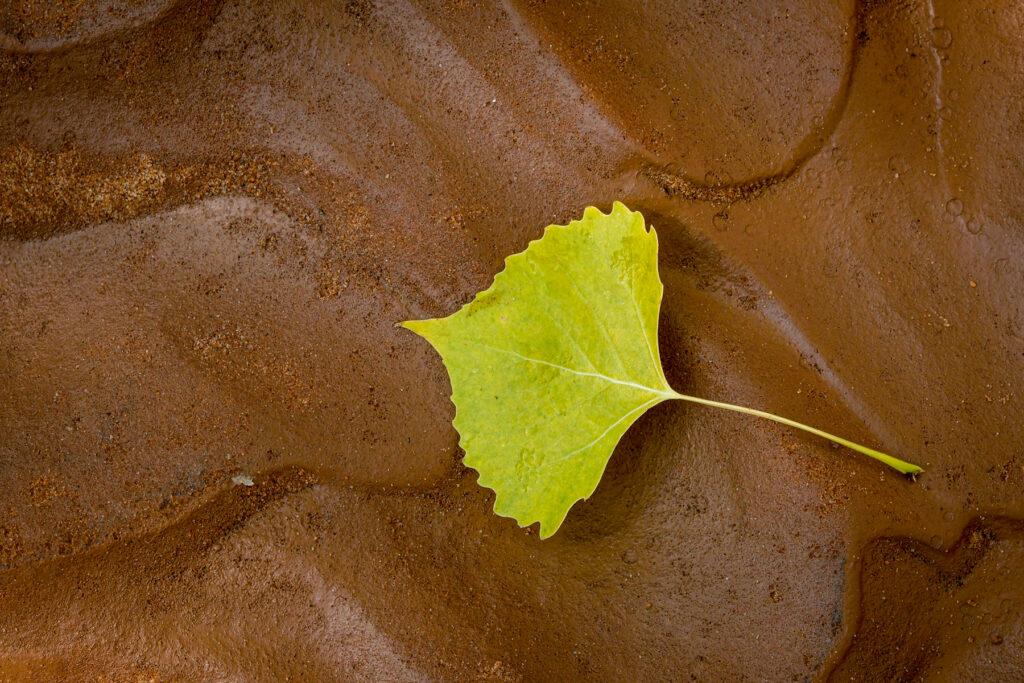


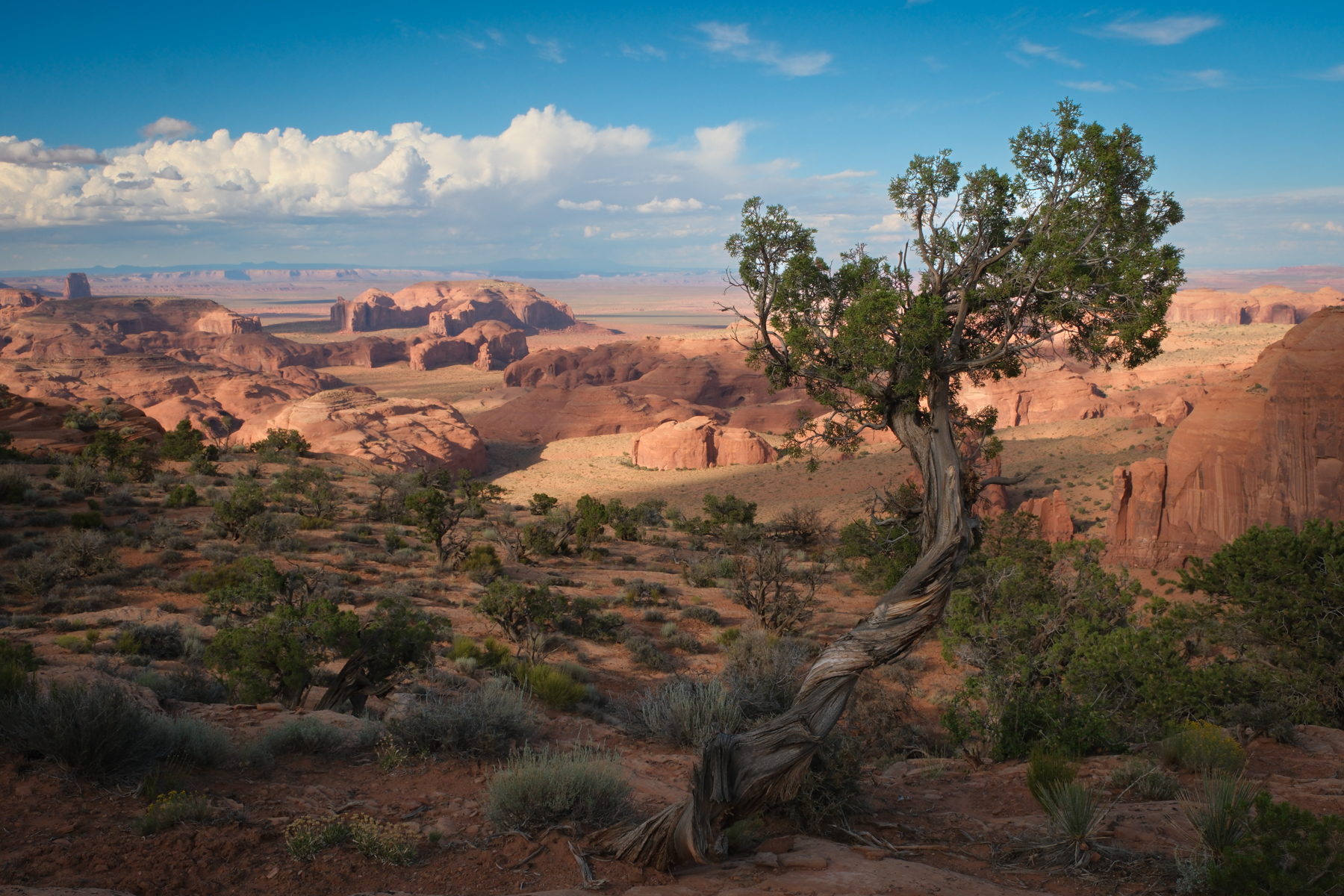
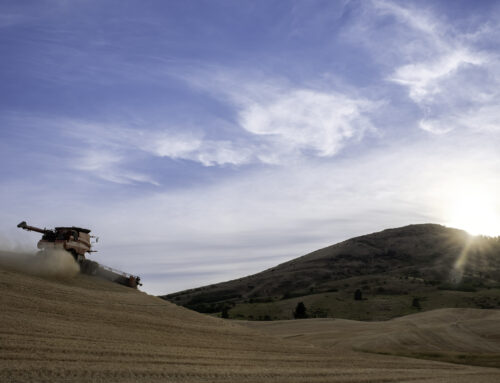
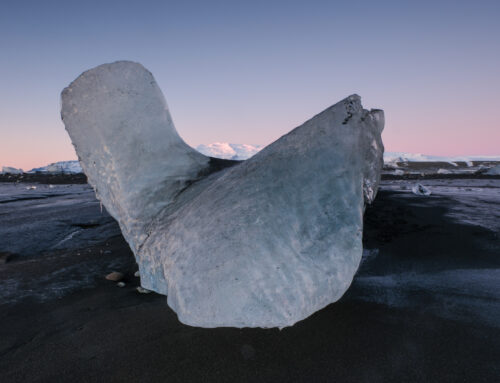
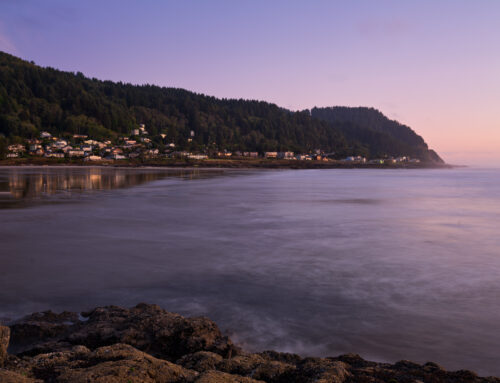
Leave A Comment